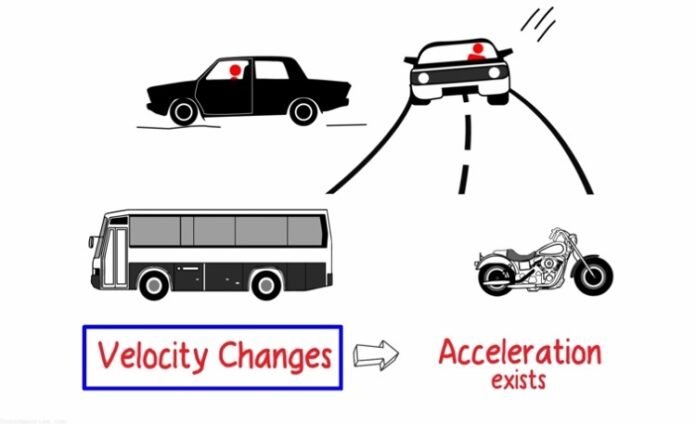Introduction
Acceleration is a fundamental concept in physics that describes the rate of change of an object’s velocity concerning time. In simpler terms, it is how quickly the speed of an object changes. Acceleration is measured in meters per second squared (m/s2). Acceleration can be positive or negative, depending on whether the object is speeding up or slowing down. For example, when a car speeds up, its acceleration is positive, whereas when it slows down, its acceleration is negative.
Understanding Acceleration
The formula for acceleration is a = Δv / Δt, where “a” represents acceleration, “Δv” represents the change in velocity, and “Δt” represents the change in time. This formula shows that the greater the change in velocity over a given period, the greater the acceleration.
For example, if a car starts from rest and then reaches a speed of 60 km/h in 10 seconds, the acceleration can be calculated using the formula as follows:
a = (60 km/h – 0 km/h) / 10 s
a = 6 km/h/s
To convert km/h/s to m/s2, we need to divide the value by 3.6. So the acceleration in
m/s^2 is:
a = 6 km/h/s ÷ 3.6
a = 1.67 m/s2
This means that the car’s speed is increasing by 1.67 meters per second every second.
Relationship between Acceleration and Force
Newton’s second law of motion states that the force acting on an object is equal to its mass multiplied by its acceleration (F = ma). This means that if an object experiences a net force, it will accelerate in the direction of that force. The greater the force acting on the object, the greater its acceleration will be.
When multiple forces act on an object, the net force is the vector sum of all the forces. If the net force on an object is zero, then the object will not accelerate. However, if the net force is nonzero, then the object will accelerate in the direction of the net force. The acceleration of the object is directly proportional to the net force acting on it and inversely proportional to its mass.
For example, consider a rocket launching into space. The rocket’s engines produce a force that propels it forward while gravity pulls it back toward Earth. Initially, the rocket’s acceleration is positive because the force of the engines is greater than the force of gravity. As the rocket gains altitude, the force of gravity decreases, and the acceleration decreases until the rocket reaches a state of weightlessness.
Applications of Acceleration
- Free Fall: One of the most common applications of acceleration is in free fall, which occurs when an object falls under the influence of gravity. In the absence of air resistance, all objects near the Earth’s surface fall with the same acceleration, known as the acceleration due to gravity, which is approximately 9.81 m/s2. This means that if an object is dropped from a height, it will accelerate toward the ground at a rate of 9.81 m/s2 until it hits the ground.
- Circular Motion: Acceleration is also important in understanding circular motion, which occurs when an object moves in a circular path. In a circular motion, the direction of an object’s velocity is constantly changing, meaning that it is accelerating even if its speed is constant. The acceleration in circular motion is called centripetal acceleration, which is always directed toward the centre of the circular path.
- Collisions: In collisions, acceleration plays an important role in determining the motion of objects before and after the collision. During a collision, objects experience forces that cause their velocities to change, resulting in acceleration. The magnitude and direction of the acceleration depend on the masses of the objects involved, the forces they experience, and the duration of the collision.
Recommended Articles:
Acceleration Time Graph – Understanding with examples
Acceleration Inclined Plane: Introduction, Laws and Calculating
AC Voltage Resistor – Introduction, Differences and Types
AC Voltage Inductor – Introduction, Work, Applications and Types
AC Voltage Capacitor – Introduction, Derivation and Applications
Speed is the rate at which an object moves, while acceleration is the rate at which an object's velocity changes. In other words, acceleration is a measure of how quickly an object's speed changes over time. Yes, an object can have acceleration but not be moving. This occurs when the object's velocity changes, but its position remains the same. For example, an object that is rotating at a constant speed but changing direction is accelerating even though it is not moving in a straight line. Acceleration is calculated by dividing the change in an object's velocity by the time it takes for that change to occur. The formula for acceleration is a = (v2 - v1) / t, where "a" is acceleration, "v2" is the final velocity, "v1" is the initial velocity, and "t" is the time interval. Air resistance is a force that opposes the motion of objects through the air. It can decrease an object's acceleration by reducing the net force acting on it. Objects that have a larger surface area or are less aerodynamic experience more air resistance and therefore have lower acceleration than objects that are streamlined and have less surface area. Some real-life examples of acceleration include a car accelerating from a stop, a rollercoaster accelerating down a hill, a rocket launching into space, a person jumping off a diving board, and a ball being thrown into the air. Additionally, the acceleration due to gravity causes all objects to accelerate toward the ground at the same rate, which is approximately 9.81 m/s2 near the Earth's surface. Acceleration FAQs
What is the difference between speed and acceleration?
Can an object have acceleration but not be moving?
What is the formula for calculating acceleration?
How does air resistance affect acceleration?
What are some real-life examples of acceleration?
